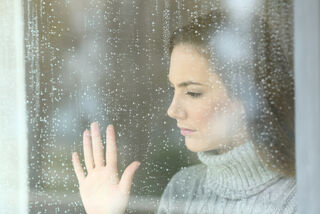Anxiety
Research Suggests a Surprising Way to Reduce Social Anxiety
Is FOBI the new FOMO?
Posted January 21, 2022 Reviewed by Ekua Hagan
Key points
- Social anxiety is a common reaction to the pandemic environment, as interpersonal skills become rusty and people fear crowded spaces.
- One meta-analysis of 13 studies of over 16,000 participants reveals that physical activity can reduce social anxiety.
- Other solutions such as planning and pacing can also dramatically reduce discomfort from social anxiety.

We are all experiencing an alien social existence these days. As the calendar page turns and we begin yet another year where social interactions continue to carry the daunting threat of medical consequences, many of us are slinking back into our safe sanctuaries and staying put. Now, instead of FOMO, the fear of missing out on social engagements, many are feeling FOBI, the fear of being included. Often, this fear is tied not only to health concerns but also to feelings of social anxiety.
Symptoms of social anxiety
We are all familiar with the concept of social anxiety. Like anything, how it affects each person is individual. If you personally don’t experience it with intensity, you probably have friends or loved ones who do.
Physically, it can manifest as avoiding eye contact, sweating, nausea, feeling faint, hyperventilating, panic attacks, and rapid heart rate. Psychologically, it may involve intense feelings of self-consciousness, embarrassment, and being negatively judged. Social anxiety may prevent people from dating, going on job interviews, attending parties and events, and other group activities.
Social anxiety and the pandemic
After almost two years of distancing, even the most gregarious and seasoned socialites may be surprised to find their interpersonal skills are rusty. Crowded places may feel stressful both for the potential of swirling germs and for the unwelcome state of being wedged in with lots of people.
Social anxiety can also deepen into social anxiety disorder, a much more serious and potentially chronic condition. Not surprisingly, as this period of pandemic pervasiveness drags on, scientists are finding that the number of people suffering from social anxiety and social anxiety disorder is rising dramatically. Notably, the numbers are worse for adolescents and young adults.
The association between exercise and social anxiety
The good news is that recent research reveals a readily available, non-medical undertaking that helps reduce social anxiety (and anxiety in general). The solution is good old physical activity. While physical activity and social anxiety may at first seem unrelated, in a recent meta-analysis of 13 studies including over 16,000 participants, researchers found that there is an association between physical activity and social anxiety, with physical activity, especially aerobic exercise, having a positive effect on social anxiety.
Taking a brisk walk, going for a bike ride, playing tennis or basketball, or doing whatever type of movement that you enjoy and that also gets your heart rate up will reduce tension, divert your attention, and cause a shift in your brain chemistry. Exercise increases the flow of positive, mood-controlling neurochemicals including serotonin, dopamine, and endorphins. And, it also builds resilience that bolsters your ability to counter negative emotions and responses.
Other solutions to social anxiety
The bottom line is that if you are feeling reluctant to socialize or discomfort in settings that never bothered you pre-pandemic, you are definitely not alone. In addition to coming out of your hidey-hole for exercise (or staying in and busting a dance move), you can also make a conscious effort to manage your feelings.
Before an activity or event, think of strategies that will help. This might include limiting the time you are there, going with a friend, thinking about who you will be excited to reconnect with there, or planning a way to recharge your batteries afterward.
And of course, go at your own pace. The more isolated you have been and the more ill at ease you feel, the slower you may want to take your re-entry. A dinner or party with a few friends may be a better place to start than a concert or a weekend at a cabin with a crowd.
These steps will help lower your stress reactions, strengthen your atrophied social muscles, and allow you to more comfortably breathe fresh life into your friendships. And if there is one thing we have learned from this pandemic, it is the value of friendship!
References
Maya A. Ziker and Linda Becker. Physical Activity as a Treatment for Social Anxiety in Clinical and Non-clinical Populations: A Systematic Review and Three Meta-Analyses for Different Study Designs. Frontiers in Human Neurscience; 2021. Doi.org/10.3389/fnhum.2021.653108


